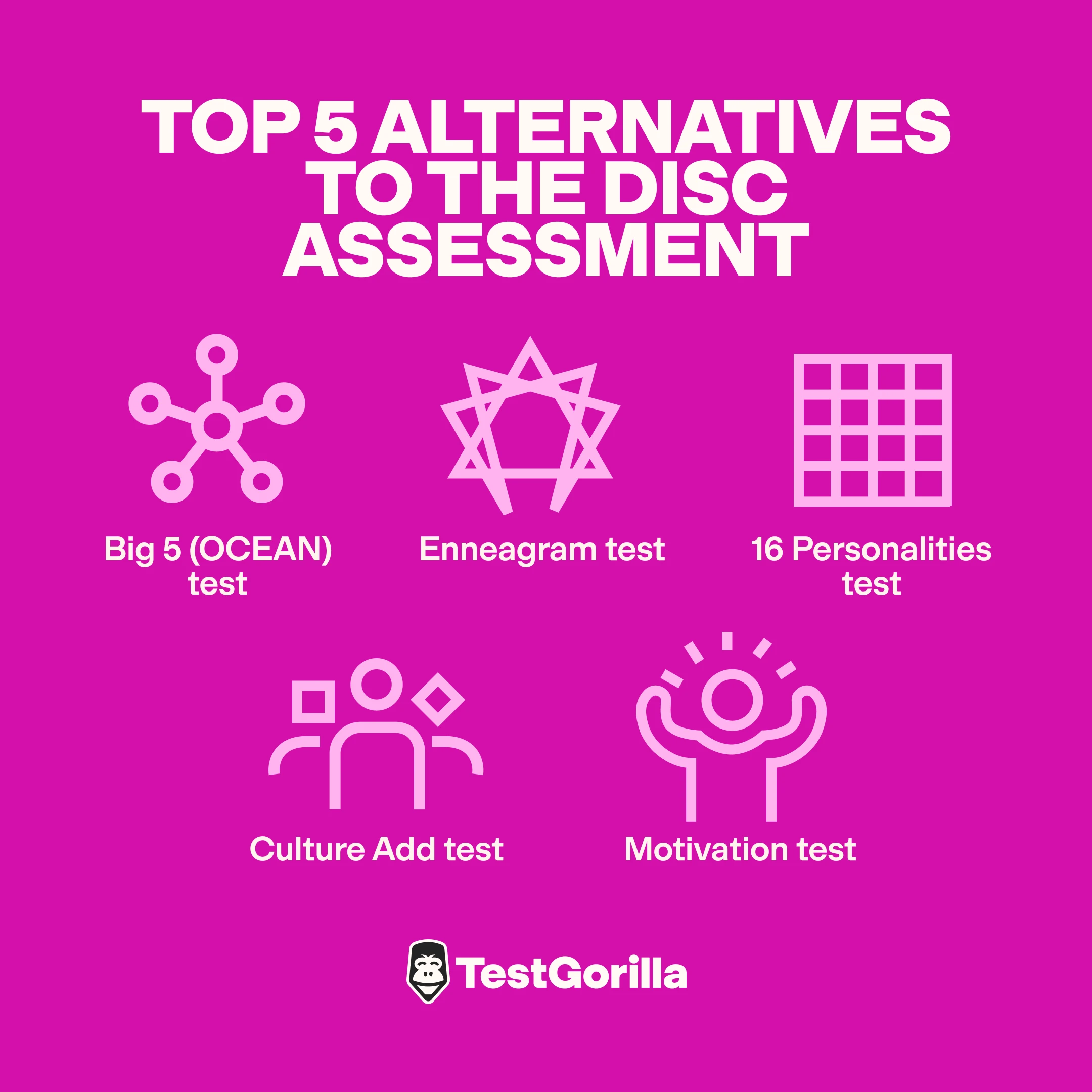Top 5 alternatives to the DISC assessment
Personality and motivation are multi-faceted, and no one workplace personality test can cover everything you need to know about a candidate or employee. While the DISC assessment has long been a staple of workplace psychometrics, it may not be the right test for your particular needs. In this article, we explore five alternatives to the DISC assessment, when to use them, and how they can help you build a winning team. Let’s dive in!
Table of contents
Key takeaways
Use the Big 5 (OCEAN) test to understand personality through five core traits: Openness, Conscientiousness, Extraversion, Agreeableness, and Neuroticism.
The Enneagram, focusing on nine distinct personality types, offers insights into deeper motivations and behavioral patterns that influence personal and professional interactions.
Based on the Myers-Briggs Type Indicator, the 16 Personalities test categorizes individuals into 16 personality types, providing a blend of traits that influence behavior and work style.
Use the Motivation test to evaluate how specific job design elements – like task variety, autonomy, and significance – influence employees' intrinsic motivation and job satisfaction.
Finally, roll out the Culture Add test to assess how a candidate’s values and behaviors align with and enhance your organizational culture. This test focuses on adding new perspectives and skills rather than just fitting existing norms.
1. Big 5 (OCEAN)
The Big 5 personality traits, also known as OCEAN (Openness, Conscientiousness, Extraversion, Agreeableness, and Neuroticism), is a psychological model that categorizes human personality into five broad dimensions. It’s rooted in decades of research and is arguably the most scientifically validated and reliable framework for understanding personality.
How it works
The Big 5 personality traits are measured using questionnaires where individuals rate themselves from “Strongly disagree” to “Strongly agree” according to various statements that relate to the five categories. For example, a statement could be, “I feel comfortable being the center of attention.”
What it tests for
The Big 5 test measures these five key personality traits:
Openness: Creativity, curiosity, and willingness to explore new experiences.
Conscientiousness: Organization, dependability, and attention to detail.
Extraversion: Sociability, assertiveness, and energy levels.
Agreeableness: Empathy, cooperation, and kindness towards others.
Neuroticism: Emotional stability, anxiety, and tendency to experience negative emotions.
When to use it
These three scenarios are ideal for using the Big 5 test:
Hiring for role fit: The Big 5 can help identify candidates whose personality aligns with the demands of specific roles. For example, high conscientiousness is crucial for detail-oriented roles, while extraversion may be beneficial in customer-facing or leadership positions.
Growth potential: Assessing traits like extraversion and conscientiousness can provide insights into a candidate’s potential for leadership positions or promotions within the company.
Predicting culture fit (or add): By evaluating traits like agreeableness and openness, HR professionals can gauge whether a candidate is likely to thrive within the company’s work culture and adapt to its values.
⭐ To learn more about the Big 5 (OCEAN) test and add it to a hiring assessment, check out TestGorilla’s Big 5 (OCEAN) test page.
2. Enneagram
Developed based on the teachings of Oscar Ichazo and Claudio Naranjo, the Enneagram personality test divides people into nine distinct personality types. Each Enneagram type reflects a core motivation, fear, and way of interacting with the world.
The nine types are:
Type 1, aka the Reformer or the Improver: Strives for perfection and upholds strong values, often critical of themselves and others.
Type 2, aka the Helper or the Giver: Empathetic and focused on meeting the needs of others, sometimes neglecting their own needs.
Type 3, aka the Achiever or the Go-Getter: Driven by a need to achieve and focused on external validation and accomplishments.
Type 4, aka the Individualist or the Contemplator: Deeply in touch with their emotions and often feels unique, sometimes to the point of feeling misunderstood.
Type 5, aka the Investigator or the Pioneer: Values knowledge and personal space, often retreating into their own thoughts and avoiding emotional overwhelm.
Type 6, aka the Loyalist or the Devoted: Loyal and seeks safety, regularly preparing for potential dangers and looking to trusted authority for guidance.
Type 7, aka the Enthusiast or the Cheerleader: Adventurous and seeks pleasure, often avoiding pain by constantly planning for exciting future experiences.
Type 8, aka the Challenger or the Master: Assertive and protective of themselves and others, frequently seeking control and resisting vulnerability.
Type 9, aka the Peacemaker or the Agreeable: Seeks harmony and avoids conflict, often going along with others’ desires to maintain peace.
How it works
The Enneagram is measured through a self-assessment that determines an individual’s core personality type and their “wings” (adjacent types that influence behavior). As in the Big 5 (OCEAN) test, Enneagram test-takers respond to statements based on how much they agree with them.
What it tests for
The Enneagram focuses on identifying:
Core motivations: What drives a person’s behavior, preferences, or decisions.
Stress triggers: What situations or environments are likely to cause a person stress or difficulty.
Orientation to opportunity: Whether a person is fast at identifying opportunities or prefers to take their time.
Interpersonal dynamics: How individuals interact with others based on their core personality type.
When to use it
You can use the Enneagram in several scenarios:
Hiring for role alignment: By understanding a candidate’s Enneagram type, you can identify whether their core motivations align with the role's demands. For example, Type 1s thrive in roles requiring high standards and precision, while Type 7s excel in dynamic, fast-paced environments.
Improving interpersonal dynamics: Knowing a candidate’s Enneagram type is a quick way to identify people who will likely work well together or how to predict future conflicts based on type-type interactions.
Tailoring development plans: The Enneagram can be used to create personalized career development plans that focus on a candidate’s growth areas and strengths, helping them succeed in the long term.
Identifying stress management strategies: Understanding the Enneagram type of a candidate can help employers identify how to support them in stressful situations, fostering resilience and job satisfaction.
⭐ Explore our Enneagram test page and our guide to the Enneagram types at their best and worst to learn more.
3. 16 Personalities
Like the Enneagram, the 16 Personalities test groups people into personality types. There are 16 potential types, each offering insight into an individual’s strengths, weaknesses, communication style, and preferences in various situations.
How it works
Individuals complete a questionnaire that assesses how they interact with the world – for example, whether they’re more introverted or extraverted, focused on details or big ideas, etc. The results place the person into one of the 16 personality types, each represented by a four-letter code (e.g., ENTJ, ISFP).
What it tests for
The 16 Personalities test measures traits across four dichotomies:
Extraversion (E) vs. Introversion (I):
Extraversion: Gains energy from social interaction and external activities.
Introversion: Gains energy from time spent alone and introspective activities.
Sensing (S) vs. Intuition (N)
Sensing: Prefers concrete, practical information obtained through the five senses, focusing on details and the present moment.
Intuition: Prefers abstract, conceptual information, focusing on patterns, possibilities, and the future.
Thinking (T) vs. Feeling (F):
Thinking: Decides based on logic, objective analysis, and consistency, prioritizing truth and fairness.
Feeling: Decides based on personal values, empathy, and the impact on others, prioritizing harmony and relationships.
Judging (J) vs. Perceiving (P):
Judging: Prefers structure, organization, and planning, aiming for closure and decisiveness.
Perceiving: Prefers flexibility, spontaneity, and keeping options open, adapting as new information arises.
When to use it
You can use the 16 Personalities test for similar reasons to the Enneagram test, as well as for:
Identifying communication styles: The 16 Personalities test helps you understand how a candidate prefers to communicate (e.g., introverted vs. extraverted). This is essential in knowing how best to communicate with the employee or candidate and how they’ll communicate with others.
Understanding decision-making processes: By identifying whether a candidate leans toward thinking (T) or feeling (F), the test helps assess whether their decision-making approach aligns with the needs of the job. For example, someone with a T in their type could be more suited to a role involving logical decision-making, like a business analyst, and someone with an F may be more suited to roles like community organizing.
Assessing ideal work environments: Traits like judging (J) vs. perceiving (P) indicate how structured or adaptable a candidate is, helping you determine if they fit roles requiring strict processes or more flexible, creative environments.
⭐ TestGorilla has its own 16 Personalities test that you can add to your hiring assessments. Check it out on our 16 Personalities test page. Then, read our guide on interpreting 16 Personalities test results.
4. Culture Add
The Culture Add test is designed to assess how a candidate’s values and behaviors align with your organization’s core values while bringing new perspectives and skills to enhance your company culture.
How it works
Employers first complete a survey that measures the importance of various values and behaviors for their workplace culture. Candidates or employees then take a test that measures their own values and behaviors, and the results are compared to the company's specified values and desired behaviors. The test identifies how well each candidate aligns with the organization’s core values and their potential to fit and add to the company culture.
What it tests for
The Culture Add test assesses:
Value alignment: How closely a candidate’s personal values match those of the organization.
Behavioral fit: Whether the candidate’s preferred behaviors align with the needs of the role.
Cultural enhancement: The potential for the candidate to introduce diverse perspectives, new skills, and innovative working styles that can positively impact the organization’s culture.
When to use it
For recruitment and HR professionals, the Culture Add test is particularly useful for the following:
Cultivating inclusive workplaces: Use the test to ensure new hires not only fit in with the existing culture but also bring fresh perspectives and skills that enhance team dynamics.
Preventing groupthink: By focusing on candidates who offer new viewpoints and skills, the test helps avoid stagnation and fosters innovation.
Building a stronger culture: Apply the test to map out how candidates’ values and behaviors contribute to a healthier, more productive organizational culture.
Ensuring value alignment: The test helps hire candidates whose core values resonate with the company’s mission, contributing to long-term cultural cohesion.
⭐ Want more insights? Explore our Culture Add test page, then read our article on how focusing on culture add can make your hiring more objective.
5. Motivation
The Motivation test is based on Oldham & Hackman’s Job Characteristics Model, a psychological framework designed to explain how certain job features influence employee motivation, satisfaction, and performance. The test focuses on five core job dimensions that determine how motivating or rewarding a job will be for an individual.
How it works
HR or hiring managers fill out a series of questions designed to measure the following variables about a specific job role:
Skill variety: The range of different skills and talents required for the job.
Task identity: The extent to which a job involves completing a whole, identifiable piece of work.
Task significance: The job’s impact on the organization or society.
Autonomy: The level of independence and decision-making the job allows.
Feedback: How much clear and direct information employees receive about their performance.
Then, candidates complete their own questionnaire about their motivations and preferences at work. Results are used to help determine a candidate’s suitability for the position.
What it tests for
The Motivation test looks at an individual’s:
Motivation potential: Whether a job’s structure is motivating enough to enhance performance.
Job satisfaction: How fulfilling an employee will find their work based on the job’s design.
Engagement: How invested and involved will employees feel in their work.
Work outcomes: How likely it is that the employee will perform well in the role.
When to use it
The Motivation test can be used for:
Crafting job requirements to suit personality: Use this model when creating or revising job roles to ensure they incorporate key motivational characteristics, like skill variety and autonomy, which can improve job satisfaction and retention.
Improving employee engagement: You can use the test with existing employees, helping you identify why certain positions may have lower engagement or performance.
Aligning role responsibilities with candidate expectations: The Motivation test can help you match candidates to roles where they’ll thrive based on their desire for feedback, autonomy, or task significance. This ensures higher motivation and long-term success.
⭐ For more information on this test, head to TestGorilla’s Motivation test page.
Understand candidate personalities with TestGorilla
While the DISC assessment is a well-evidenced test and a mainstay in workplace psychometrics, it’s far from the only option. As we’ve seen, there are many other variables to consider when filling a job role or cultivating your dream team.
Need to revise job requirements based on employee personality? Try the Motivation test. Need a quick summary of employee personality types to predict how people will work with one another or excel in certain roles? The Enneagram or 16 Personalities tests have you covered.
All of the above tests have their place, but not all test providers are created equal.
TestGorilla works with psychologists and expert psychometricians to ensure our personality tests are accurate. Whether you’re looking for a single personality test or want to mix and match tests, we have you covered! We offer the DISC test and all five alternatives discussed in this article.
Get started today for free, or register for a 45-minute demo and see how TestGorilla can help you make smarter hiring decisions.
FAQs
What is the best, most accurate personality test?
While there is a place for every personality test, the Big 5 (OCEAN) model is considered the most scientifically validated personality test on the market. Decades of research validate both its accuracy and the efficacy of its use, and many think of it as the best personality test.
What is similar to the DISC assessment?
The most similar personality test to the DISC assessment is the 16 Personalities test. This test is about placing test-takers into categories that will predict their responses to certain environments and situations.
Related posts
You've scrolled this far
Why not try TestGorilla for free, and see what happens when you put skills first.
Latest posts
The best advice on pre-employment testing, in your inbox.
No spam. Unsubscribe at any time.

Hire the best. No bias. No stress.
Our screening tests identify the best candidates and make your hiring decisions faster, easier, and bias-free.
Free resources
This checklist covers key features you should look for when choosing a skills testing platform
This resource will help you develop an onboarding checklist for new hires.
How to assess your candidates' attention to detail.
Learn how to get human resources certified through HRCI or SHRM.
Learn how you can improve the level of talent at your company.
Learn how CapitalT reduced hiring bias with online skills assessments.
Learn how to make the resume process more efficient and more effective.
Improve your hiring strategy with these 7 critical recruitment metrics.
Learn how Sukhi decreased time spent reviewing resumes by 83%!
Hire more efficiently with these hacks that 99% of recruiters aren't using.
Make a business case for diversity and inclusion initiatives with this data.




















